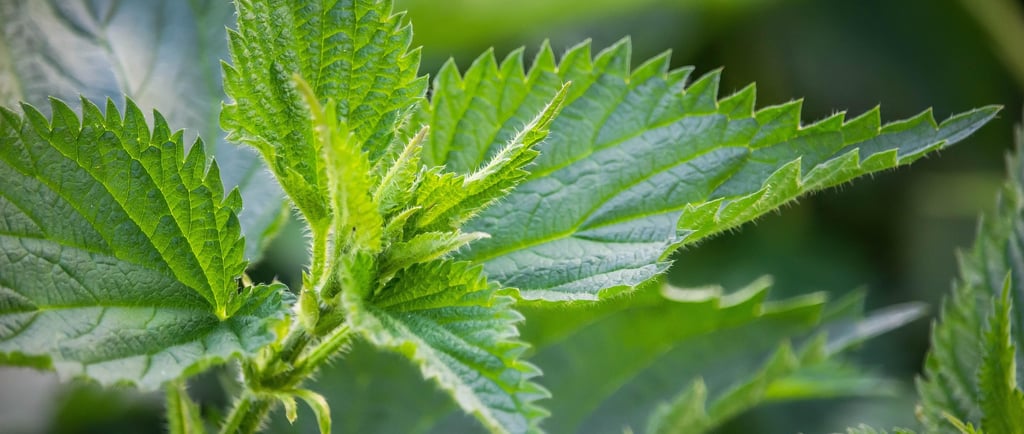👑 The Queen of Sting 🌿 The Nettle 🧤
🌱 A follow-up story that connects Chapters The Leaf, The Root, and The Flower of the Biology Album. 🍃🪱🌸 This story invites children to meet a powerful green guardian—the nettle—whose humble heart-shaped leaves are edged like saws and guarded by stinging hairs. Exploring cordate leaf shapes and serrate margins, this tale awakens curiosity about plant structure and self-defense, while also diving deep—underground—to reveal how roots draw minerals from the soil like silent seekers. 🌿🧤 Children discover that this fierce plant has not only protected itself for centuries, but also provided food, fiber, medicine, and magic across many cultures. Nettle’s role in ecology, as a host for butterflies and friend to pollinators, shows her place in a larger web of life. This story sparks wonder: What other plants use trichomes to protect themselves? What changes when a plant begins to flower? And who dares to dine on the Queen of Sting? 👑🐛🌍
BIOLOGY STORIES
4/19/20253 min read


It's spring! 🌱✨ The greatest and greenest show on Earth begins! Tiny leaves are peeking out of buds, stretching toward the sun. But hiding among them… is a stinging queen! She doesn’t wear jewels or sit on a throne—but her cloak is deep green, her power ancient, and her sting unforgettable. Her name is Nettle 👏 Net 👏 tle 👏—the Queen of Sting.
The name nettle comes from the Old English netel, related to the word needle—because of her sting! 🪡 You might find her standing tall at the edge of a path, near a fence, or under the trees. Her leaves are shaped like hearts with edges like saws—in plant language, that’s a cordate shape (from Latin cor, meaning “heart” ❤️) with serrate margins (from Latin serra, meaning “saw” 🪚). And if you look closely, you’ll see the veins spreading from the center outward—just like fingers from a palm. That’s palmate venation! 🍃
At first glance, she looks soft and delicate—but don’t be fooled! Her surface is covered in tiny stinging hairs called trichomes 👏 tri 👏 chomes 👏 that act like miniature syringes. The word comes from the Greek trikhos, meaning “hair.” When touched, their tips break and inject a mix of acids that gives a surprising zap! ⚡ It’s her way of saying, “Stay Away!" 🧤 But this is because she is hiding gifts that will amaze you. ✨
Nettle draws minerals up from deep in the soil with her underground seekers—her roots. They act like tiny straws, sipping iron, calcium, potassium, and magnesium from the soil. 💪🌱 That’s why people once called her a living multivitamin !
🌿 When nettle is young, her leaves are full of these minerals and vitamins. For thousands of years, people around the world have used her as food and medicine. In Europe, nettle soups were nature's gift after long winters. In Asia and the Middle East, nettle teas were brewed to strengthen the blood and clean the body. 🍵 In Indigenous traditions of North America, tribes respected nettle as a plant of many purposes—for easing pain, healing skin, and even soothing allergies.
And not just medicine! Nettle is a natural dye and a fiber plant too—her strong stems can be turned into string and cloth. In ancient times, people used nettle fibers to make nets, ropes, and clothes. Even soldiers’ uniforms during war were sometimes made from nettle thread when other materials were scarce. 🧶
But here’s an important secret known by traditional foragers: 🌸 Once nettle blooms, most of her energy and nutrients go into her tiny greenish flowers—leaving the leaves more bitter and less useful. That’s why people only harvest young tops before flowering, with great respect for the queen and her cycle of life. 🌿👑
Nettle is also a great friend to wildlife. Her leaves are nurseries for butterflies, especially the Peacock and Red Admiral. These butterflies lay their eggs on the bottom of the nettle leaves. When the caterpillars hatch they love to munch them. 🐛🦋
🌬️ And the legends? Oh yes. The Celts planted nettles as boundary markers—protectors of sacred places. While Slavic tribes believed that a bundle of dried nettles hung by the door would keep away bad spirits. And in Irish folklore, nettles growing near a house were signs of ancient settlements and hidden memories beneath the soil. 🍀
Let's go outside and investigate nettle! Don't forget the magnifying glass and pair of garden gloves!
I wonder... if we can spot the trichomes on their stem and leaves ? Does Deat Nettle have trichomes too ? We might even find some butterfly eggs underneath the leaves. 🐛 Is there animals brave enough to eat the Queen of Sting? 🦌 What other plants protect themselves with hairs or chemicals?
✨🌿 Possible Follow-Up Explorations 🌿✨
Stinging Plant Investigation 🧤🧪
How: Research other plants with stinging or protective structures. What’s their strategy?
Why: Discover plant defense adaptations and compare species.
Nettle Look-Alikes: Mimicry in the Plant World 🎭🌱
How: Investigate plants that look like nettles but don’t sting—like Dead Nettle (Lamium). Why do they mimic the Queen of Sting? What are the clues to tell them apart?
Why: Encourage close observation and introduce the concept of mimicry in nature. Children love plant mysteries!
Nettle Legends and Herbal Timeline 📖🕰️
How: Collect stories and uses of nettles across cultures. Create a class “Nettle Stories.”
Why: Connect botany with oral tradition, history, and culture.
Cooked or Raw? Nettle in the Kitchen 🥣🍵
How: Try a safe, adult-guided preparation of cooked nettle tea or soup.
Why: Experience plants as edible, and explore how preparation transforms plant properties.
Butterfly Habitat Map 🦋🗺️
How: Research butterflies that rely on nettle and map their migration or life cycle.
Why: Learn about food chains and animal-plant interdependence.
Pollinator Watch 🐝
How: Observe a nettle patch (or any flowering plant) and record who visits! Caterpillars? Ants? Bees?Why: Build ecological awareness and observation skills.
With Montessori joy,
Vanina 😊

